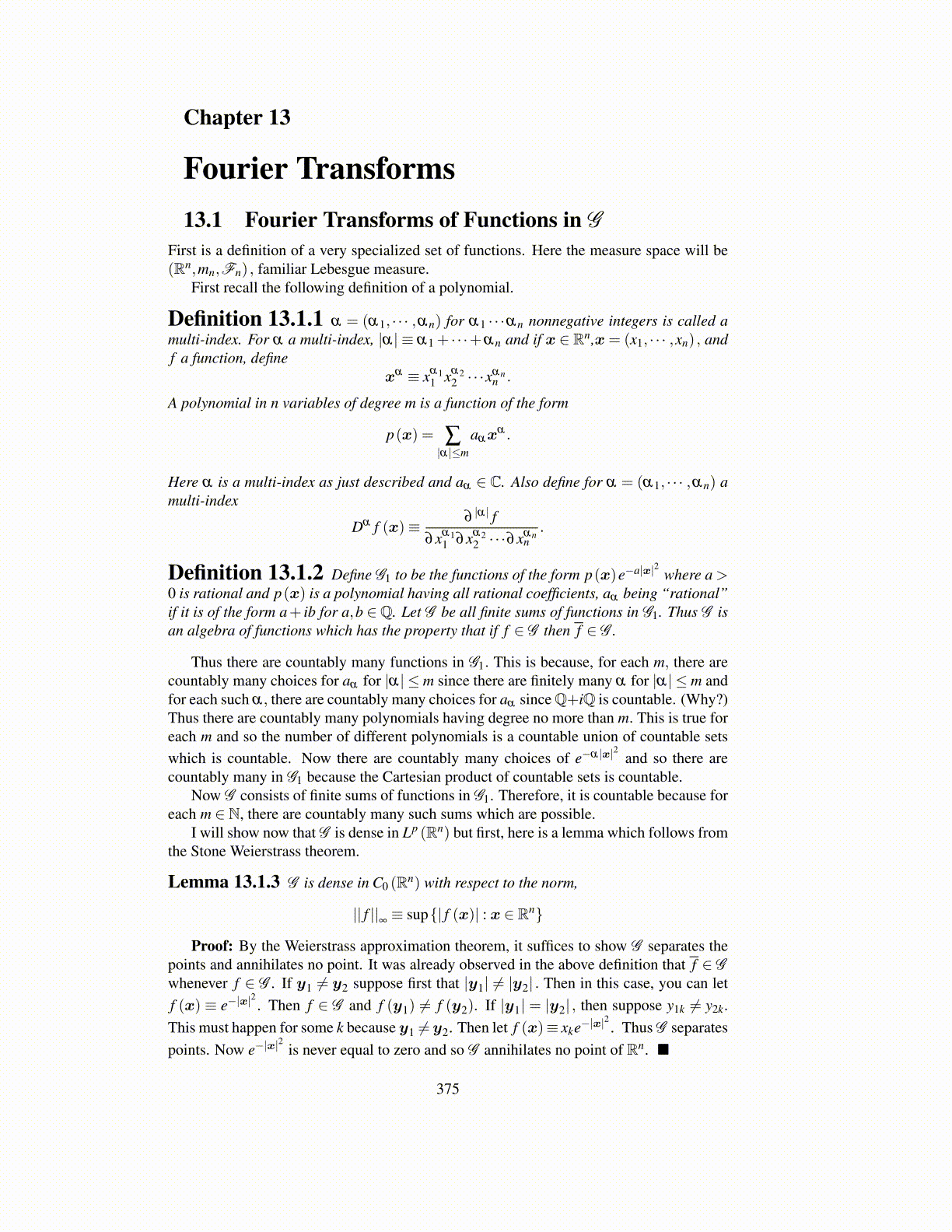
Chapter 13
Fourier Transforms13.1 Fourier Transforms of Functions in G
First is a definition of a very specialized set of functions. Here the measure space will be(Rn,mn,Fn) , familiar Lebesgue measure.
First recall the following definition of a polynomial.
Definition 13.1.1 α = (α1, · · · ,αn) for α1 · · ·αn nonnegative integers is called amulti-index. For α a multi-index, |α| ≡ α1 + · · ·+αn and if x ∈ Rn,x= (x1, · · · ,xn) , andf a function, define
xα ≡ xα11 xα2
2 · · ·xαnn .
A polynomial in n variables of degree m is a function of the form
p(x) = ∑|α|≤m
aαxα .
Here α is a multi-index as just described and aα ∈ C. Also define for α = (α1, · · · ,αn) amulti-index
Dα f (x)≡ ∂ |α| f∂xα1
1 ∂xα22 · · ·∂xαn
n.
Definition 13.1.2 Define G1 to be the functions of the form p(x)e−a|x|2 where a >0 is rational and p(x) is a polynomial having all rational coefficients, aα being “rational”if it is of the form a+ ib for a,b ∈Q. Let G be all finite sums of functions in G1. Thus G isan algebra of functions which has the property that if f ∈ G then f ∈ G .
Thus there are countably many functions in G1. This is because, for each m, there arecountably many choices for aα for |α| ≤m since there are finitely many α for |α| ≤m andfor each such α, there are countably many choices for aα sinceQ+iQ is countable. (Why?)Thus there are countably many polynomials having degree no more than m. This is true foreach m and so the number of different polynomials is a countable union of countable setswhich is countable. Now there are countably many choices of e−α|x|2 and so there arecountably many in G1 because the Cartesian product of countable sets is countable.
Now G consists of finite sums of functions in G1. Therefore, it is countable because foreach m ∈ N, there are countably many such sums which are possible.
I will show now that G is dense in Lp (Rn) but first, here is a lemma which follows fromthe Stone Weierstrass theorem.
Lemma 13.1.3 G is dense in C0 (Rn) with respect to the norm,
|| f ||∞≡ sup{| f (x)| : x ∈ Rn}
Proof: By the Weierstrass approximation theorem, it suffices to show G separates thepoints and annihilates no point. It was already observed in the above definition that f ∈ Gwhenever f ∈ G . If y1 ̸= y2 suppose first that |y1| ̸= |y2| . Then in this case, you can letf (x) ≡ e−|x|
2. Then f ∈ G and f (y1) ̸= f (y2). If |y1| = |y2| , then suppose y1k ̸= y2k.
This must happen for some k because y1 ̸=y2. Then let f (x)≡ xke−|x|2. Thus G separates
points. Now e−|x|2
is never equal to zero and so G annihilates no point of Rn. ■
375